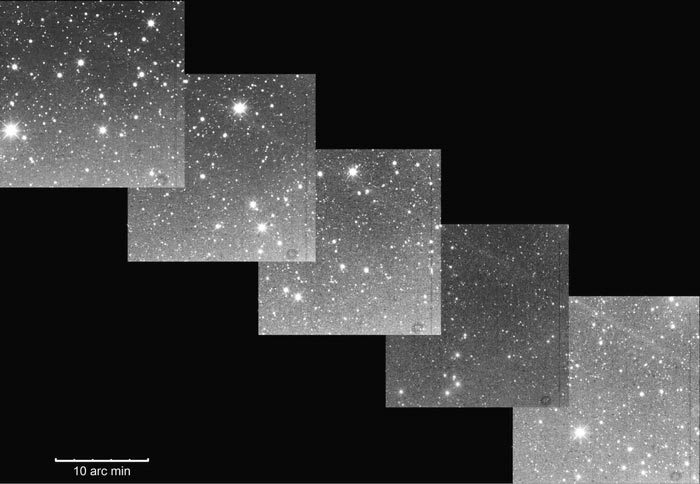Scientists discover comet’s hourglass-shaped dust trail

Photographs of observations of the comet's dust trail in 2015 taken by researchers.
Photo: Arto Oksanen
A model with increased accuracy of calculations helped to explain the unusual shape.
Researchers from Finland, Canada, and Russia have discovered an unusual, hourglass-shaped dust trail of the comet 17P/Holmes. The particles that formed the dust trail were released by the most powerful of the documented thus far outbursts by a comet. It happened in October 2007. Astronomers carried out observations of the cometary dust trail using telescopes in Australia, Finland, and the USA. The first stage of observations lasted from 2013 to 2015. The second one was from 2020 to 2021. The description of this research published in one of the world’s oldest scientific journals on astronomy and astrophysics Monthly Notices of the Royal Astronomical Society. The research is supported by the Academy of Finland.
The authors of the study found out for the first time that the orbits of the cometary particles ejected in the outburst form an hourglass shape. On the opposite sides of the trail there are nodes of convergence of orbits along which particles move. One, the northern node, is located at the original point of the comet’s outburst, the other, the southern node, is located on the opposite side. The smallest particles have the largest orbits, so they arrive at the nodes last, particles of medium and large size arrive at the nodes earlier.
“The enormous amount of particles that were ejected from the comet during the outburst spread out in elliptical orbits around the Sun. This provides a unique opportunity to study the cometary material and its dispersion in interplanetary space. To understand the physics and scale of this phenomenon, we developed a new model that realistically describes the evolution of the resulting cometary dust trails,” says Maria Gritsevich, academic project leader, adjunct professor at the University of Helsinki and senior researcher at the Finnish Geospatial Research Institute and Ural Federal University.
The research results make it possible to predict the location and behavior of comet 17P/Holmes’ dust trail, including its way back to the original outburst point. In addition, research can help in calculating following cometary outbursts or predict the occurrence and intensity of meteor showers.
“Since 2000, I have been modeling well-known meteor showers (such as the Leonids) using modern modeling techniques. In this study, we have developed high-precision models of the outburst of the comet 17P/Holmes itself and the propagation of the resulting dust particles. Moreover, we combined both models for the first time and this resulted in a powerful new model,” says Markku Nissinen, a member of the Finnish Fireball Network at the Ursa Astronomical Association.
The uniqueness of the model is that it takes into account the effects of solar radiation pressure, gravitational disturbances caused by Venus, the Earth and the Moon, Mars, Jupiter and Saturn, as well as the gravitational interaction of dust particles with the parent comet.
“We predict that with our published data on the time of arrival and the corresponding coordinates of the dust trail of the comet 17P/Holmes in 2022 it will be visible even in the telescopes of amateur astronomers. We expect that the results of their observations will provide additional information about the number and size of the particles and their geospatial distribution. This information will be useful for developing new models and understanding what happens to the comet and its trail”, concludes Maria Gritsevich.
Scientists will continue to study the comet 17P/Holmes to determine the reasons for the periodic increase in brightness, possible secondary and seasonal effects (such as non-gravitational and irregular radiation pressure) on the particles, and the possibility of observing in the infrared wavelength range. In addition, future research plans are to simulate the first observed comet outburst in 1892 and its consequences.
Note
Comet 17P/Holmes was discovered during an outburst on November 6, 1892, by the British astronomer Edwin Holmes. Another powerful outburst occurred on October 23-24, 2007 and lasted for about three hours. The outburst was the largest ever recorded in the history of astronomical observations. Due to release of particles and enormous increase in the size of the surface reflecting the sunlight, the brightness of the comet increased 1 million times. For the brief moment, the comet also became the largest object in the Solar System.
Journal: Monthly Notices of the Royal Astronomical Society
DOI: 10.1093/mnras/stac822
Method of Research: Observational study
Article Title: Evolution of the dust trail of comet 17P/Holmes
Article Publication Date: 29-Mar-2022
Media Contact
Anna Marinovich
Ural Federal University
anna.marinovich@urfu.ru
Office: 343-389-94-07
Cell: 961-770-6024
Original Source
All latest news from the category: Physics and Astronomy
This area deals with the fundamental laws and building blocks of nature and how they interact, the properties and the behavior of matter, and research into space and time and their structures.
innovations-report provides in-depth reports and articles on subjects such as astrophysics, laser technologies, nuclear, quantum, particle and solid-state physics, nanotechnologies, planetary research and findings (Mars, Venus) and developments related to the Hubble Telescope.
Newest articles

Innovative 3D printed scaffolds offer new hope for bone healing
Researchers at the Institute for Bioengineering of Catalonia have developed novel 3D printed PLA-CaP scaffolds that promote blood vessel formation, ensuring better healing and regeneration of bone tissue. Bone is…

The surprising role of gut infection in Alzheimer’s disease
ASU- and Banner Alzheimer’s Institute-led study implicates link between a common virus and the disease, which travels from the gut to the brain and may be a target for antiviral…

Molecular gardening: New enzymes discovered for protein modification pruning
How deubiquitinases USP53 and USP54 cleave long polyubiquitin chains and how the former is linked to liver disease in children. Deubiquitinases (DUBs) are enzymes used by cells to trim protein…


